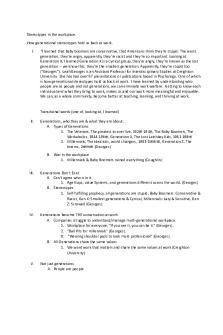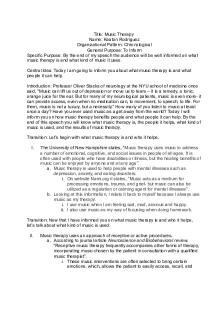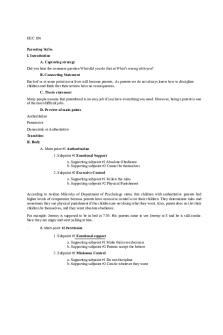Informative speach bayard rustin PDF

| Title | Informative speach bayard rustin |
|---|---|
| Course | Intro to Public Speaking |
| Institution | University of Akron |
| Pages | 4 |
| File Size | 89.9 KB |
| File Type | |
| Total Downloads | 2 |
| Total Views | 121 |
Summary
summary of Bayard Rustin and his contribution to the Civil Rights Movement...
Description
Topic: Bayard Rustin Specific Purpose: To inform my audience about the life of Bayard Rustin. Thesis: Bayard Rustin’s legacy can properly be summed up by three main facts about his life. Introduction Attention-getting device: I came here today to tell all of you about the man that homophobia has erased from history. Given that it’s Black History Month, I’m sure you’re all sick of relearning about the same five people, whereas there were many important figures involved in the integration of African Americans into American society. Bayard Rustin’s life was consumed by social equality, such as the Civil Rights Movement and employment equality between races, and the fact that he was a homosexual changed how he will be remembered by the public. Credibility: I have obtained this information though established authors; such as Shari Hatch and Elizabeth Cazden who wrote about Bayard Rustin in a chapter of African-American Writers: A Dictionary and the Biography Reference Bank, respectively. Thesis: Bayard Rustin’s legacy can properly be summed up by three main facts about his life. Main Points: First, I will discuss Bayard Rustin’s role in the Civil Rights Movement. Next, I will explain his objective of reaching equal employment for African-Americans. Finally, I will review how his sexuality prevented any public recognition for his work. Body 1. Bayard played an essential role in the Civil Rights Movement. a. Bayard was a part of a large coalition of allies that supported and worked with Martin Luther King Jr. and shared his philosophy of nonviolence. i. He spread his philosophy of nonviolence, as well as organized nonviolent protests. 1. This was an important essence of the Civil Rights Movement that led to its success: nonviolence. (Cazden, 2013) ii. Bayard is known for saying “I want no human being to die or to be brutalized” which really reinforces his idea of peace. (Hatch, 2000)
b. Being the right hand man to Martin Luther King Jr., Bayard Rustin helped organize Freedom Rides, bus integration protests, and was a key organizer of the March on Washington in 1963, which is where Martin Luther King Jr. gave his famous “I had a dream” speech (Haughton, 1999) c. Don’t devalue Bayard’s work for the Civil Rights Movement because he wasn’t on the front line; in fact, Bayard was described to be rambunctious and made a point to disrupt everyday life, which he did successfully. (Carbado, 2004) i. He was the mastermind behind most protests. ii. He led sit-downs and peaceful protests in order to achieve equal rights and the right to vote for African Americans. [Transition: After the passage of the Civil Rights Act of 1964, Bayard Rustin continued to fight for the improvement of social equality.] 2. Bayard Rustin lived a life full of battling social inequality. He continued his work in order to achieve total equality in the country by working to enforce employment equality for African-Americans. a. Bayard Rustin continued is work in fixing economic problems of the working class and issues for unemployment of African Americans. (Haughton, 1999) b. Bayard believed that after the passing of civil rights laws, the Civil Rights Movement left a state of protest and entered an era of politics i. Bayard was known as a “master strategist and tireless activist” by bringing Gandhi’s protest techniques to America for the Civil Rights Movement, as well as making Martin Luther King Jr. into an international symbol of peace. (Hatch, 2000) [Transition: Now that you have learned about Bayard Rustin’s work after the Civil Rights Movement, I will describe how his personal life interfered with his work.] 3. Finally, Bayard Rustin was a homosexual black man living in the 1950’s, so naturally, there was heavy criticism and attacks from the white, right-wing opposition that resulted in Bayard staying behind the scenes of the movement. a. Bayard Rustin was kept out of the spotlight because he was a homosexual and was caught in a car consensually with two other men. i. He was charged with “sexual perversion” to which he pled guilty. b. Provided his verdict, Bayard was asked to leave several organizations that he was affiliated with; such as the Fellowship of Reconciliation and the pacifist Civil Rights organization that he worked for. (Haughton, 1999) i. Bayard Rustin was then advised to work behind the scenes for the Civil Rights Movement by many members of the cause.
ii. His associates did not wish for him to stay behind the scenes because of any homophobia issues, but because they wanted to avoid any smearing and attacks from opposing parties. Conclusion Summary: Today I first discussed Bayard Rustin’s role in the Civil Rights Movement. Then I informed you about his work after 1964. Lastly, I explained why we don’t learn about Bayard Rustin’s contribution to the history of our country. Conclusion: The best way to sum up the life of Bayard Rustin is to use his own final summary of his life’s work. He said, “The principal factors which influenced my life are 1) nonviolent tactics; 2) constitutional means; 3) democratic procedures; 4) respect for human personality; 5) a belief that all people are one”
Works Cited Carbado, Devon W., and Donald Weise. "The Civil Rights Identity Of Bayard Rustin." Texas Law Review 82.5 (2004): 1133-1195.Business Source Complete. Web. 17 Feb. 2015. Cazden, Elizabeth. "Behind The Scenes Bayard Rustin." Cobblestone 34.2 (2013): 12. Biography Reference Bank (H.W. Wilson). Web. 17 Feb. 2015. Hatch, Shari Dorantes, and Michael R. Strickland. African-American Writers : A Dictionary. Santa Barbara, Calif: ABC-CLIO, 2000.eBook Collection (EBSCOhost). Web. 17 Feb. 2015. Haughton, Buzz. "Bayard Rustin- Civil Rights Leader." Quaker Info. N.p., Feb. 1999. Web. 3 Feb. 2015. Muravchik, Joshua. "Fifty Years After The March." Commentary 136.2 (2013): 31-37. Literary Reference Center. Web. 17 Feb. 2015....
Similar Free PDFs

Informative speach bayard rustin
- 4 Pages

Speach outline fin al version
- 4 Pages

Informative Speech
- 3 Pages

Informative speech
- 3 Pages

Informative Speech
- 3 Pages

Informative speech
- 4 Pages

Informative 2Reflection
- 1 Pages

Informative Speech
- 3 Pages

INFORMATIVE SPEECH
- 6 Pages

Informative Speech
- 3 Pages

Informative outline
- 5 Pages

Informative Speech
- 8 Pages

informative speaking
- 4 Pages

Informative Speech
- 5 Pages
Popular Institutions
- Tinajero National High School - Annex
- Politeknik Caltex Riau
- Yokohama City University
- SGT University
- University of Al-Qadisiyah
- Divine Word College of Vigan
- Techniek College Rotterdam
- Universidade de Santiago
- Universiti Teknologi MARA Cawangan Johor Kampus Pasir Gudang
- Poltekkes Kemenkes Yogyakarta
- Baguio City National High School
- Colegio san marcos
- preparatoria uno
- Centro de Bachillerato Tecnológico Industrial y de Servicios No. 107
- Dalian Maritime University
- Quang Trung Secondary School
- Colegio Tecnológico en Informática
- Corporación Regional de Educación Superior
- Grupo CEDVA
- Dar Al Uloom University
- Centro de Estudios Preuniversitarios de la Universidad Nacional de Ingeniería
- 上智大学
- Aakash International School, Nuna Majara
- San Felipe Neri Catholic School
- Kang Chiao International School - New Taipei City
- Misamis Occidental National High School
- Institución Educativa Escuela Normal Juan Ladrilleros
- Kolehiyo ng Pantukan
- Batanes State College
- Instituto Continental
- Sekolah Menengah Kejuruan Kesehatan Kaltara (Tarakan)
- Colegio de La Inmaculada Concepcion - Cebu

